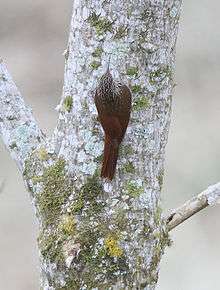Streak-headed woodcreeper
The streak-headed woodcreeper (Lepidocolaptes souleyetii) is a passerine bird which breeds in the tropical New World from southern Mexico to northwestern Peru, northern Brazil and Guyana, and also on Trinidad.
| Streak-headed woodcreeper | |
|---|---|
.jpg) | |
| Scientific classification | |
| Kingdom: | Animalia |
| Phylum: | Chordata |
| Class: | Aves |
| Order: | Passeriformes |
| Family: | Furnariidae |
| Genus: | Lepidocolaptes |
| Species: | L. souleyetii |
| Binomial name | |
| Lepidocolaptes souleyetii (Des Murs, 1849) | |
This woodcreeper is found in lowlands up to 1,500 m (4,900 ft) altitude, although normally below 900 m (3,000 ft), in damp light woodland, plantations, gardens, and clearings with trees. It builds a leaf-lined nest 4.5 to 24 m (15 to 79 ft) up in a tree cavity, or sometimes an old woodpecker hole, and lays two white eggs.
The streak-headed woodcreeper is typically 19 cm (7.5 in) long and weighs 28 g (0.99 oz). It has olive brown upperparts with fine streaking on the crown, nape and upper back, a chestnut rump, wings and tail, and heavily streaked olive-brown underparts. The 2.5 cm (0.98 in) long bill is slender and decurved. Young birds are duller with less distinct streaking.
The call is a sharp rolled djeer and the song is a whistled piiiiiiiiir piiiiiiiiir piiiiiiiiir.
The streak-headed woodcreeper is very similar to the spot-crowned woodcreeper (Lepidocolaptes affinis) but is smaller, has a streaked, not spotted crown, and is found at lower altitudes.
The streak-headed woodcreeper feeds on spiders and insects, creeping up trunks and extracting its prey from the bark or mosses. It is normally seen alone or in a pair and unlike spot-crowned, rarely joins mixed-species feeding flocks.
This species' scientific name commemorates Louis François Auguste Souleyet, French zoologist and naval surgeon.

References
- BirdLife International (2012). "Lepidocolaptes souleyetii". IUCN Red List of Threatened Species. 2012. Retrieved 26 November 2013.CS1 maint: ref=harv (link)
- Stiles, F. Gary; Skutch, Alexander F. (1989). A Guide to the Birds of Costa Rica. Comstock Publishing Associates. ISBN 0-8014-9600-4.
- Hilty, Steven L. (2003). Birds of Venezuela. Princeton University Press. ISBN 0-7136-6418-5.
External links
| Wikimedia Commons has media related to Lepidocolaptes souleyetii. |
| Wikispecies has information related to Lepidocolaptes souleyetii |
- "Streak-headed woodcreeper media". Internet Bird Collection.
- Streak-headed woodcreeper photo gallery at VIREO (Drexel University)
- Streak-headed woodcreeper species account at Neotropical Birds (Cornell Lab of Ornithology)
- Interactive range map of Lepidocolaptes souleyetii at IUCN Red List maps
